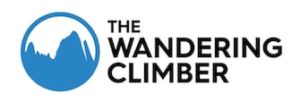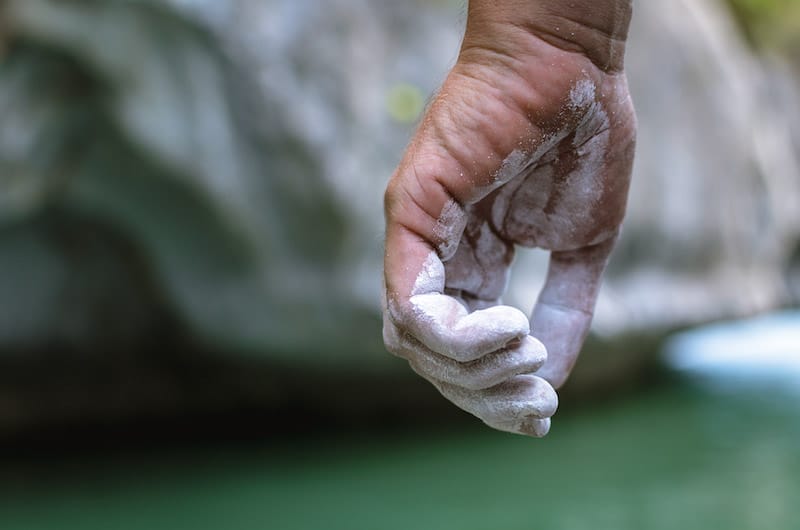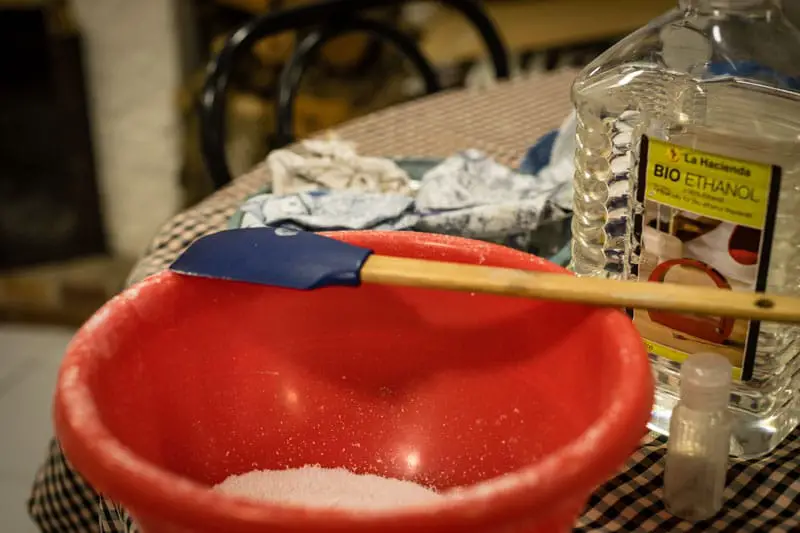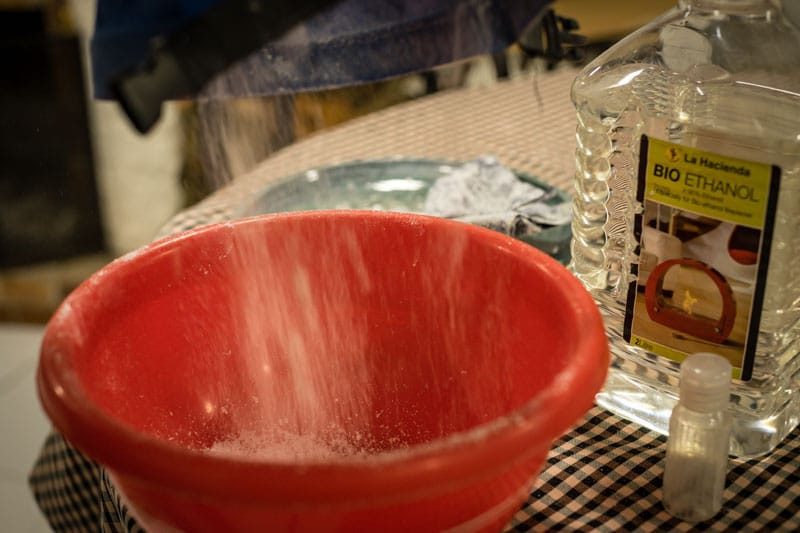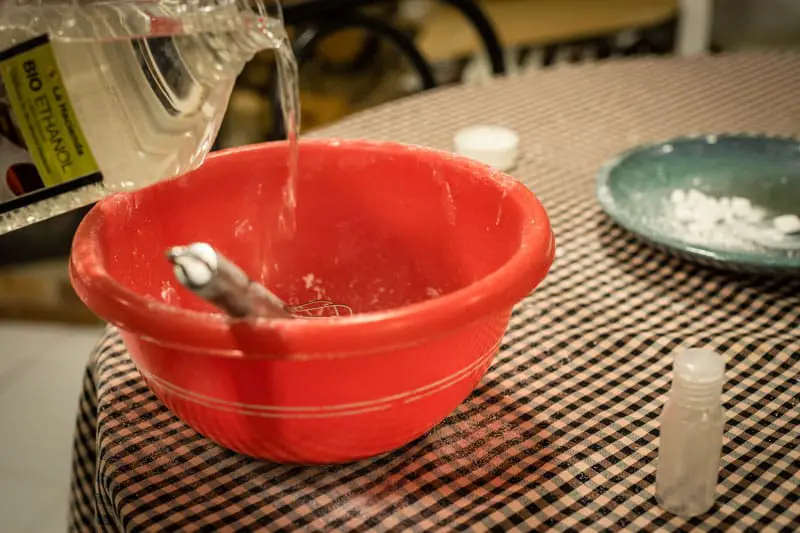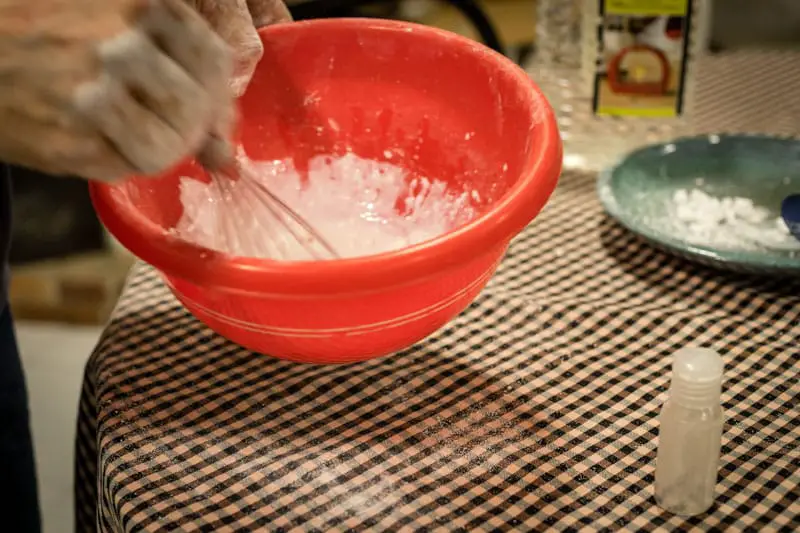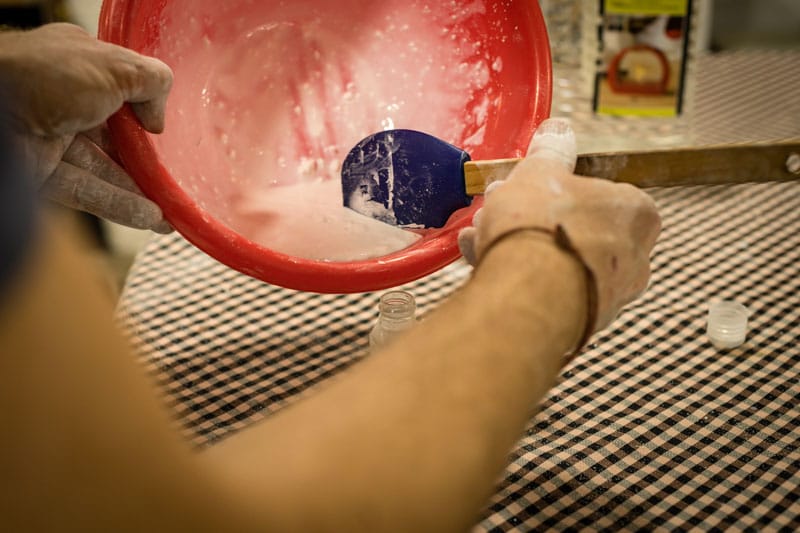Step-by-step guide to make your own liquid chalk at home. Save money, impress your friends, and send your routes!
Hey! By the way… this page contains affiliate links. So if you make a purchase after clicking one at no cost to you we may earn a small commission. Thanks for your support!
What is Liquid Chalk?
What is liquid chalk you might ask? Liquid chalk is made of the same stuff as normal chalk, only in liquid form. It might be seen as the last step in the evolutionary chain of chalk. If you haven’t used it before, liquid chalk is simply a combination of regular chalk and a type of alcohol, forming a liquid that you apply to your hands. The alcohol evaporates leaving an even layer of chalk magically coating your hands.
Is Liquid Chalk good for Climbing?
You may be asking why use liquid chalk? Is liquid chalk good for climbing? Why not just use normal chalk?
Well, the liquid variety, including the homemade liquid chalk we’ll shortly be showing you how to make, has a few advantages over its solid predecessor.
Has your gym banned powdered chalk for health and covid reasons? Then liquid chalk could be your solution.
Do a lot of deep water soloing and can’t afford to fall in the water with your chalk bag each try? Then how about liquid chalk.
Need some extra reassurance of dry hands through the crux on your project? Yep, you guessed it!
Why Use Liquid Chalk?
Other reasons to make liquid chalk include, like our title suggests, to save money.
Climbers have long been seen as dirtbags, scraping together what money and savings they can to fund that next climbing trip. Saving some dollars by making your own liquid chalk is the logical extension of that.
In a similar wallet watching vein, liquid chalk is very economical. It only takes a small amount that can be precisely dosed before each climb.
Eco friendly climbers may want to try this too, taking control of the ingredients used, saving waste by reusing old liquid chalk bottles or buying the climbing chalk and alcohol in bulk to make liquid chalk on the go.
Wastage is very little, too, especially when compared to loose chalk that mostly seems to end up in the air and subsequently in the environment.
If you think that a little wasted chalk is nothing then check out this informative article about the hidden environmental cost of climbing chalk.
Recipe for the Best DIY Liquid Climbing Chalk
What You Need
If you’ve used liquid chalk before you may, like me, have been amazed at the magical qualities it seemed to possess.
But like so many other mysterious things, the science behind it is actually quite simple, and the ingredients list very short. Essentially, it boils down to a combination of magnesium carbonate (regular chalk) and alcohol (we will look at the different types you could use below).
Here is a list of everything you may need to make liquid chalk yourself:
- “Normal” chalk
- Alcohol
- Large bowl or similar for mixing
- Silicon spatula / whisk / wooden spoon
- Container(s) for bottling
Powdered Chalk
What powdered chalk to use is an individual choice – different people each have their own preferences. Chalk quality and consistency can vary quite drastically between manufacturers – and this can be reflected in price.
Friction Labs has a well renowned reputation for producing premium chalk differentiated by a colorful cast of animals in different textures.
Black Diamond is another popular option, and comes in at a more affordable price.
Check Price and Reviews On Amazon
Chalk also comes in blocks, and these are often the most affordable option, but you will have to crush the chalk down to a powder yourself. For this recipe we recommend using the finest loose chalk as it will be easier to avoid lumps forming when you mix the ingredients. Or, like us, you can just grab all the leftovers from a few bags for a fun experiment!
Alcohol
The alcohol in the diy liquid chalk is the magic ingredient, and the one that will most greatly affect the final product. In essence, it is a holder for the liquid chalk that evaporates after application, leaving only the chalk on your hands.
Pure ethanol would probably be the best but is also quite expensive. Rubbing alcohol is popular as it is inexpensive, but look for one which has an alcohol content of at least 70% otherwise you’ll be left waiting ages for it to evaporate. We used a bioethanol, which gave great results (not as smelly as rubbing alcohol), was very cheap and is eco friendly.
Note – we have heard rumours of some climbers even using vodka to make liquid chalk… we can never verify or deny these claims, however, if you decide to try this route then let us know how it goes!
Mixing bowl
Anything large enough to hold all the ingredients will do, the bigger the better! Don’t worry about ruining your favorite mixing bowl for baking – the ingredients will wash right off afterwards.
Silicon Spatula / Whisk / Wooden Spoon
Either will do the job, but we found a silicon spatula to be best in combination with a whisk for those pesky lumps that form when you over excitedly add the alcohol all at once…!
Using a Airtight Container for Bottling
The important thing here is to remember we need to form as much of an airtight seal as we can to prevent the alcohol from evaporating out of the liquid chalk, as well as being able to squeeze out the liquid chalk.
Small recycled shampoo bottles work very well.
How to Make Liquid Chalk ~ Step By Step
To make liquid chalk we’ll be drawing on years of baking and cooking experience. We took on this challenge the same way we would baking a cake or making a pancake batter!
Start by transferring the dry ingredient, magnesium carbonate (MgCO3), into your chosen mixing bowl. If you’re starting with a fine loose chalk then great, if you’re starting from a block of chalk or left overs like us then make sure it is as fine as possible.
Since this could end up being quite a messy process we found if you placed the chalk inside a plastic bag before crushing you avoided most of the dust clouds and ensuing cleanup required.
Whilst we made our homemade liquid chalk in the kitchen, in hindsight it would have been a better use of our time to do it outside as it seemed to go everywhere!
Once finely crushed you can slowly begin to add in your isopropyl alcohol. A ratio of 2 parts climbing chalk to 1 part alcohol seemed to give us the consistency we’re looking for – however this may vary depending on your own choice of ingredients.
Make sure to start slowly, add the isopropyl alcohol in a thin stream, little by little, and continue whisking until completely absorbed. Repeat this process until you have the consistency of a toothpaste. We started by using a whisk but quickly found out that a silicon spatula worked much better, and helped us in the next step to avoid any wastage when bottling.
Bottling
Make sure to work quick to transfer the mixed liquid chalk from your bowl into your chosen airtight container. We decided not to make too much in the first round to see how well it would store, putting some into an old travel shampoo bottle, perfect for taking to the crag, and the rest in an airtight jar for later.
What is Climbing Chalk Made Of?
Climbing chalk is made of MgCO3, a broken down form of the mineral Magnesite. It is very effective at absorbing water without breaking down, therefore makes for a perfect companion for rock climbers with sweaty hands!
Rock climbing companies often add other chemicals or minerals to make their chalk stand out from the competition.
Other ingredients often include drying agents, essential oils and limestone. Many of the more expensive chalks claim to use a purer form of MgCO3 that will fill the pores in your skin better and absorb water more effectively, but this may just be a finer version of the same mineral.
There is, however, one ingredient that is more efficient at absorbing moisture than MgCO3 called Upsalite.
Best Liquid Chalks
And if after reading this, you’ve decided to just leave it up to the pros, check out our article on the best liquid chalk brands out there!
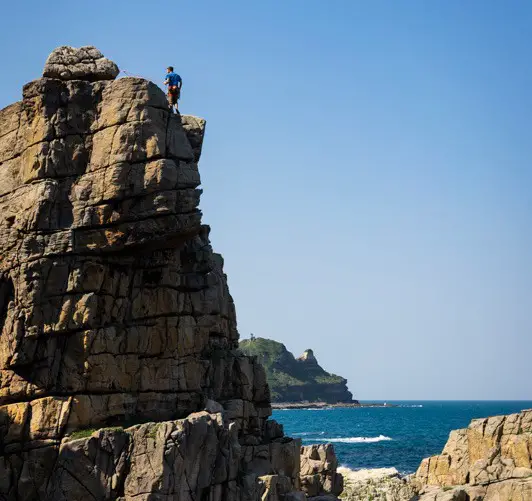
UK born and bred, once a passionate dirtbag Neil has finally traded it all in (read sold out!) for a comfortable life behind a desk in the climbing paradise of Siurana. He still dreams of his years spent living out of a tent / car / backpack and shunning the whole world (wide web) in glorious destinations from Taiwan to Thailand, Squamish to South Devon and many, many more.
Aside from climbing Neil is attempting to learn Spanish (despite living in Catalonia), thinks the environment is worth saving and his favourite food is toast with tomato, garlic and oil (Pa amb tomàquet).
